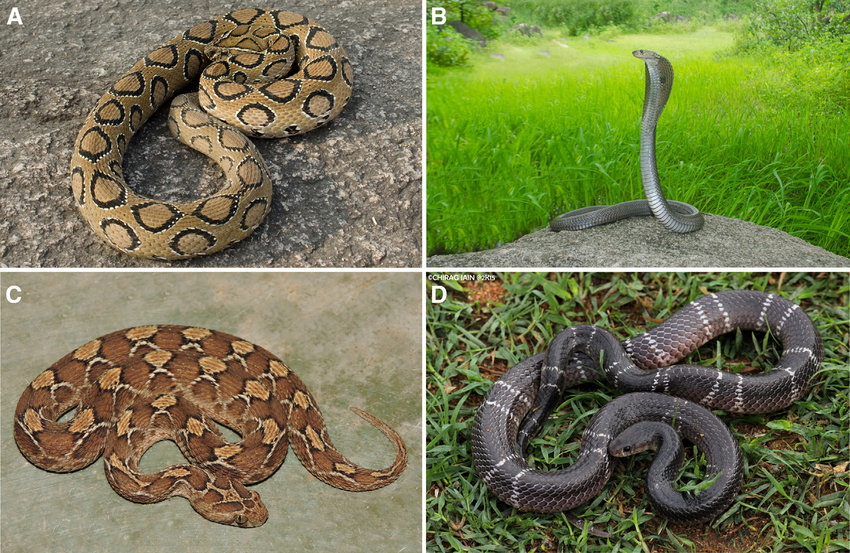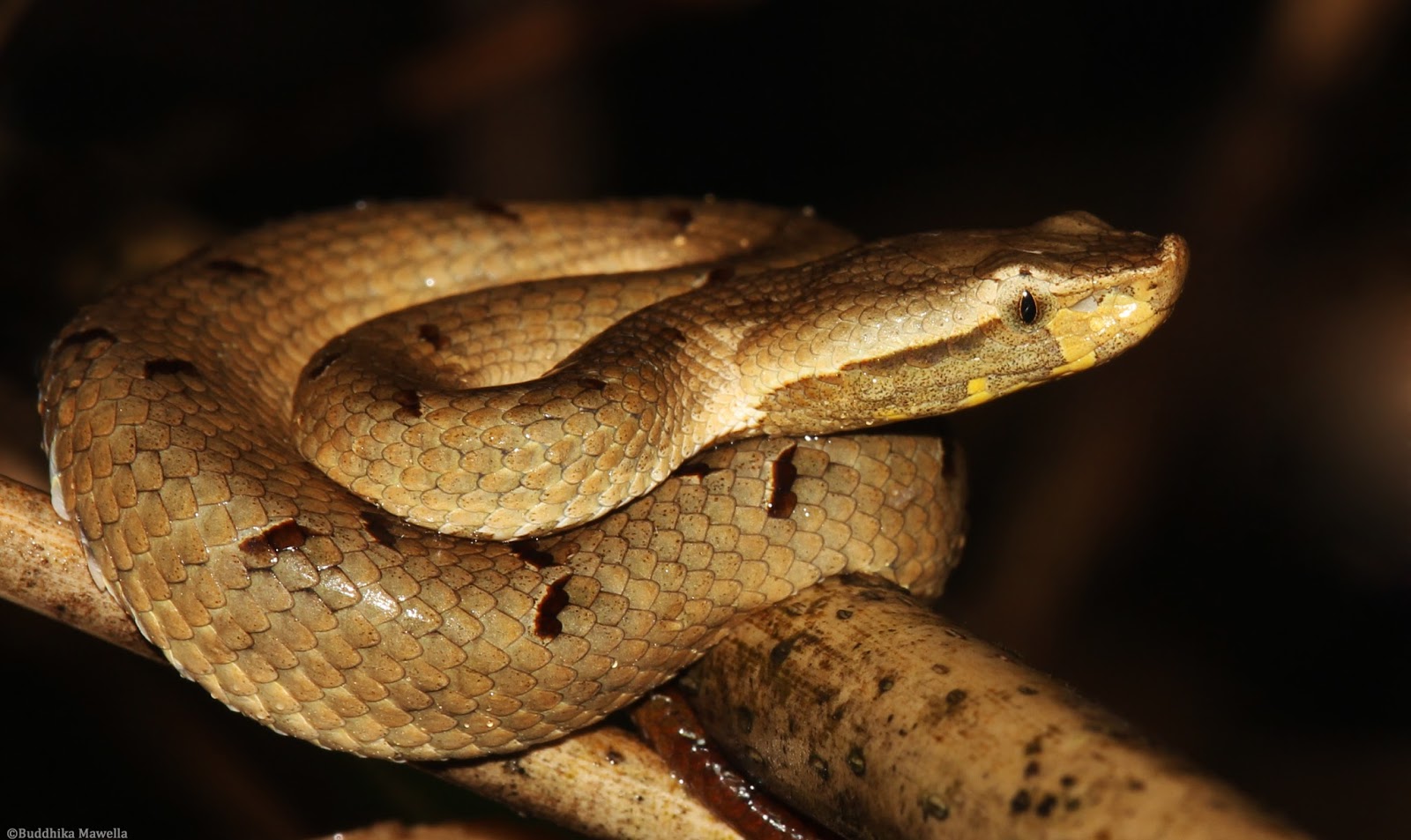The hump-nosed pit viper has many oddities — starting with its name — but the most fearsome is the fact that there is no antidote available for its deadly venom.
That makes the hump-nosed pit viper (Hypnale hypnale), also called the hump-nosed moccasin for its pointed and upturned snout, a major killer endemic to Sri Lanka and the Western Ghats, a mountain range of South India. The standard polyvalent antivenom used for the four most poisonous snakes of the region — the Indian cobra (Naja naja), Indian krait (Bangarus caeruleus), Russell's viper (Daboia russelii) and Saw-scaled viper (Echis carinatus) — does not work on hump-nosed pit viper venom.
A: Russell's viper/ B:Indian cobra/ C: Saw-scaled vipe/ D: Krait
Worse, the polyvalent antivenom, which is made in India and exported to Sri Lanka and several African countries, can result in massive allergic reactions when administered to a victim bitten by a hump-nosed pit viper or by a species other than the Big Four.
Following detailed studies in the 1990s, the hump-nosed pit viper was recognised as a medically important snake. As a result, researchers began questioning the prevalence of the Big Four in clinical, toxicological and biological studies, while other venomous species have remained neglected. Even now, most of the scientific literature on the hump-nosed pit viper is confined to Southern India or Sri Lanka.
“Because the hump-nosed pit viper was not seen to be as deadly as the Big Four, no study on its venom and treatment was carried out, resulting in high levels of mortality and morbidity,” says Sajeeth Kumar, researcher at the Government Medical College in Kozhikode, Kerala, and lead author of a study on poisonous snakes published in the International Journal of General Medicine.
“Where the bite of the hump-nosed pit viper was thought to result only in local envenoming it turned out that there were serious systemic effects as well with more than one organ affected,” Kumar tells SciDev.Net. “Our study of 1,500 toxic snakebite cases showed that hump-nosed pit viper envenomation typically brings on acute kidney injury leading to corticoid necrosis and death.”
Most bite victims suffer from coagulopathy, a condition in which the blood loses its ability to clot, resulting in internal bleeding that may last six days on average, calling for close medical management.
“Finding the particular component in hump-nosed pit viper venom that stops blood from clotting could be of major therapeutic importance,” says Kumar. He points to studies aimed at developing medicines from viper venom, such as blood thinners, that can prevent the unwanted clot formation responsible for cardiac arrest, stroke and hypertension.
The leading cause of death from hump-nosed pit viper bites is capillary leak syndrome, a condition in which fluid and proteins leak out of tiny blood vessels into surrounding tissue. This results in dangerously low blood pressure and a decrease in blood plasma volume.
“Capillary leak syndrome is refractory to any standard treatment measure and adds to the complications of treating a venomous hump-nosed pit viper bite,” says Kumar. “This is why lack of awareness, delayed hospitalisation and treatment by non-medical personnel add to the risk of mortality where hump-nosed pit vipers are concerned.”
In the absence of antivenom, basic medical facilities needed for the management of hump-nosed pit viper bites include blood dialysis machines that can help save the kidneys, ventilators in the event of respiratory distress and fresh, frozen plasma for use on patients that show signs of coagulopathy.
 English: Highland Hump-nosed Pit Viper Binomial: Hypnale nepa. Sinhala: කදුකර මූකලන් තෙලිස්සා
English: Highland Hump-nosed Pit Viper Binomial: Hypnale nepa. Sinhala: කදුකර මූකලන් තෙලිස්සා
“It is clear that we urgently need to develop and manufacture antivenom with activity against hump-nosed pit viper venom,” says Kumar. “We are hopeful that the polyvalent antivenom, presently undergoing clinical trials in Sri Lanka, would be useful in South India.”
The polyvalent antivenom being developed by Sri Lanka’s University of Peradeniya, in close collaboration with the Instituto Clodomiro Picado in Costa Rica, contains antivenom specific to Sri Lankan hump-nosed pit vipers.
Sri Lanka initiated the project after it was discovered that polyvalent antivenom being imported from India was not only useless against the hump-nosed pit viper, but also triggered severe allergic reactions in an unacceptably large number of cases.
Adverse reactions to the Indian antivenom makes it “part of the problem” of treating snakebite, says Sarath Kotagama, conservationist and emeritus professor of environmental sciences at the University of Colombo. “There are differences in the venom of Indian and Sri Lankan snakes, although both belong to the same species.”
According to Indian experts, variability in composition and potency of snake venom is common across species, so much so that India is now putting in place a policy of producing antivenom for specific areas. “Ecological and environmental factors, gender, age, diet and season are among factors that affect snake venom composition,” says Kartik Sunager, a researcher on snake venom at the Indian Institute of Science in Bangalore.
The new, polyvalent antivenom has demonstrated, in pre-clinical trials, capability in neutralising the venom of Sri Lanka’s three main viperid species — the Russel’s viper, the saw-scaled viper and the hump-nosed pit viper. The inclusion of hump-nosed pit viper antibodies makes it the only antivenom available for the treatment of this species anywhere, but commercial manufacture is yet to begin.
“The danger from hump-nosed pit viper bites also has to do with its mottled grey and brown colouring overlaid with a pattern of dark spots that camouflages the nocturnal animal well as it rests during the day among dead leaves, bushes and fallen logs,” says V.T. Vijayakumar, an environmentalist who specialises in snakes. “Though slow-moving, it has an irritable disposition when disturbed and strikes fast.”
“It is well for unsuspecting farmers and trekkers to remember these attributes because, for now, the only way to prevent hump-nosed pit viper envenomation is to stay clear of the reptile,” Vijayakumar says.
This piece was produced by SciDev.Net’s Global desk.

Leave your comments
Login to post a comment
Post comment as a guest